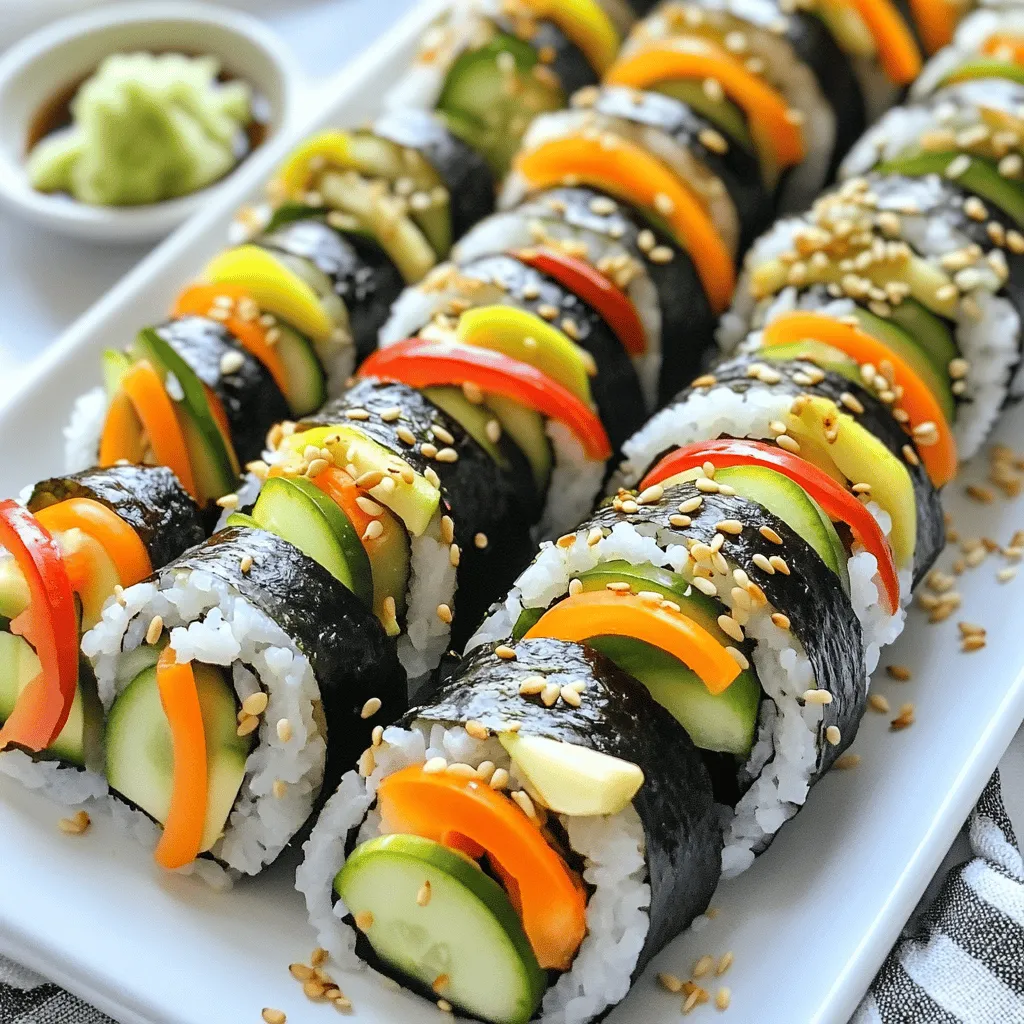Looking to make a delicious, fresh treat at home? Simple veggie sushi rolls are your answer! With just a few easy steps, you can craft these tasty bites packed with flavor and crunch. From selecting the best vegetables to mastering the rolling technique, I’ll guide you through every part of the process. Get ready to impress your friends and family with your sushi skills! Let’s roll into it!
Ingredients
Essential Ingredients for Simple Veggie Sushi Rolls
To make tasty veggie sushi rolls, you need a few key items. Here’s what you’ll need:
– 1 cup sushi rice
– 1 1/4 cups water
– 4 sheets nori (seaweed)
– 1 large cucumber, julienned
– 1 medium carrot, julienned
– 1 avocado, sliced
– 1/4 cup bell pepper, thinly sliced
– 2 tablespoons rice vinegar
– 1 teaspoon sugar
– 1/2 teaspoon salt
– Soy sauce, for dipping
– Pickled ginger and wasabi, for serving (optional)
These ingredients create a fresh and fun sushi experience that everyone can enjoy.
Optional Ingredients for Extra Flavor
If you want to add more taste, include these optional items:
– Cream cheese for a creamy texture
– Sesame seeds for crunch
– Radish sprouts for a peppery bite
– Other colorful veggies, like zucchini or sprouts
These extras can make your sushi rolls even more exciting and delicious.
Tips for Selecting Fresh Vegetables
Picking fresh veggies is key to great sushi rolls. Here are a few tips:
– Choose firm cucumbers and carrots. They should feel crisp.
– Look for ripe avocados that yield slightly when pressed.
– Select bell peppers with smooth skin and no blemishes.
– Buy locally sourced vegetables when possible for the best flavor.
Fresh ingredients will enhance your sushi rolls and make them stand out. Enjoy the process and be creative!
Step-by-Step Instructions
Preparing the Sushi Rice
– Rinsing and Cooking the Rice
Start by rinsing the sushi rice under cold water. Keep rinsing until the water runs clear. This step removes excess starch. Then, drain the rice well. Next, combine the rinsed rice with 1 1/4 cups of water in a pot. Bring this mixture to a boil. Once boiling, cover the pot and reduce the heat to low. Let it cook for 18-20 minutes. The water will absorb, and the rice will be ready. After cooking, remove the pot from heat and let it sit, covered, for 10 minutes.
– Mixing the Seasoning
In a small bowl, mix 2 tablespoons of rice vinegar, 1 teaspoon of sugar, and 1/2 teaspoon of salt. Stir until the sugar dissolves. Pour this mixture over the cooked rice. Use a wooden spatula to gently fold the seasoning into the rice. This gives the rice a nice flavor. Let the rice cool to room temperature before using it.
Assembling the Sushi Rolls
– Using the Bamboo Sushi Mat
Place your bamboo sushi mat on a flat surface. Lay a sheet of nori, shiny side down, on the mat. This setup helps you roll the sushi easily. Make sure the nori is centered on the mat.
– Layering Ingredients Correctly
With wet hands, take about 1/4 of the sushi rice. Spread it evenly over the nori, leaving about 1 inch at the top edge. This open space helps seal the roll later. Now, arrange a line of your favorite veggies like cucumber, carrot, avocado, and bell pepper across the middle of the rice.
Rolling Techniques
– Tips for a Tight Roll
Carefully lift the edge of the sushi mat closest to you. Start rolling away from yourself, pressing firmly but gently. Aim for a tight roll but don’t squish it. Roll until you reach the end of the nori. To seal the roll, use a bit of water on the edge.
– Cutting Even Pieces
Use a sharp knife to slice the roll into 6-8 pieces. To make clean cuts, wipe the knife with a damp cloth between slices. This keeps your rolls looking nice. Repeat this process with the remaining nori, rice, and vegetables.
Enjoy your simple veggie sushi rolls!
Tips & Tricks
Best Practices for Sushi Rolling
To roll sushi well, start with a clean space. Use a bamboo mat for support. Always wet your hands before handling rice. This prevents sticking. Spread rice evenly on the nori. Leave an inch at the top. Layer your veggies in the center. Roll tightly but not too hard. Use the mat to guide the roll. Seal the edge with a bit of water.
Common Mistakes to Avoid
One common mistake is too much rice. This makes rolling hard. Avoid overfilling with ingredients, too. If you add too much, the roll may burst. Another mistake is not wetting your hands. This can lead to sticky fingers and messy rolls. Lastly, don’t rush. Take your time to roll tightly and evenly.
How to Achieve the Perfect Rice Texture
Perfect sushi rice should be sticky yet fluffy. Rinse the rice well to remove excess starch. This helps the grains stay separate. Cook it with the right water ratio. Use 1 cup of rice to 1 1/4 cups of water. After cooking, let it sit covered for 10 minutes. This allows steam to finish the cooking. Mix in vinegar, sugar, and salt while the rice is warm. This adds flavor and helps with texture.

Variations
Creative Vegetable Combinations
You can play with many veggies for your sushi rolls. Try using bell peppers, radishes, or even sweet potatoes. Each vegetable adds a unique flavor and texture. Mix colors for a pretty look on your plate. For example, use purple cabbage for crunch and color. You can also add leafy greens like spinach for extra nutrition. Don’t be afraid to experiment!
Switching Up the Sauces
Soy sauce is great, but you can switch it up. Try using sesame oil for a nutty taste. A spicy mayo made with mayonnaise and sriracha can add a kick. You might enjoy a sweet soy glaze for a fun twist. Each sauce can change the whole dish. Just remember to keep the sauces balanced. You want to enhance, not overpower the fresh veggies.
Making Sushi with Cooked Ingredients
Cooked ingredients can make sushi rolls easier and different. Try using grilled zucchini or roasted carrots. You can also add cooked shrimp or crab for a seafood option. Cooked veggies are soft and mix well with rice. They can add a smoky or sweet flavor to your rolls. Just make sure they cool before adding them to your sushi.
For the complete recipe, check out the Simple Veggie Sushi Rolls 🥒.
Storage Info
Best Ways to Store Leftover Sushi Rolls
To keep your leftover sushi rolls fresh, wrap them in plastic wrap. This seals in moisture and keeps the rolls from drying out. Place them in an airtight container in the fridge. Enjoy your sushi within 24 hours for the best taste. If you have cut pieces, store them separately to maintain their shape.
How to Keep Ingredients Fresh
When you make sushi, use fresh ingredients for the best flavor. Store vegetables like cucumber, avocado, and carrot in the fridge. Keep them in a container with a damp paper towel. This helps them stay crisp. Avoid cutting vegetables too early. Cut them just before making the rolls to keep them fresh longer.
Reheating Sushi: Tips & Tricks
Sushi is best when served fresh, but if you need to reheat it, do so carefully. Microwave sushi for about 10-15 seconds on low power. This warms it without turning it soggy. Avoid reheating sushi rolls with raw fish, as they are best enjoyed cold.
FAQs
Can I Use Brown Rice for Sushi?
Yes, you can use brown rice for sushi. Brown rice has a nutty flavor. It is also more nutritious than white rice. However, it takes longer to cook. I suggest soaking it for a few hours before cooking. This can help soften it. The texture will be chewier than sushi rice. You may need to adjust the water ratio to get the right consistency.
What Can I Substitute for Nori?
If you need a substitute for nori, try soy paper or rice paper. Soy paper is thin and has a mild taste. It works well for sushi rolls. Rice paper is another option. It is often used in spring rolls. Just wet it to make it flexible before using. You can also use lettuce leaves for a fresh twist. They add crunch and keep the sushi light.
How Do I Make Sushi Rice Without a Rice Cooker?
Making sushi rice without a rice cooker is easy. Start by rinsing the sushi rice until the water is clear. Then, combine the rice and water in a pot. Bring it to a boil. Once boiling, cover and reduce the heat to low. Cook for about 18-20 minutes until the water is absorbed. Remove it from heat and let it sit for 10 minutes. Finally, mix in the rice vinegar, sugar, and salt. This method gives you perfect sushi rice every time.
You learned about making simple veggie sushi rolls using fresh ingredients. We discussed tips for preparing sushi rice and assembling the rolls. I shared common mistakes to avoid and ways to make your sushi unique. Storing and reheating sushi properly is key to enjoying leftovers. Remember, practice makes perfect when rolling. Experiment with flavors and have fun. Enjoy your sushi journey!


